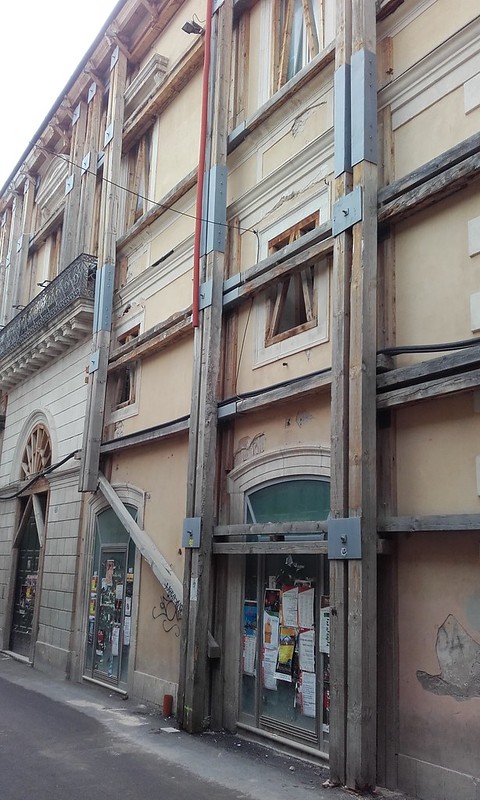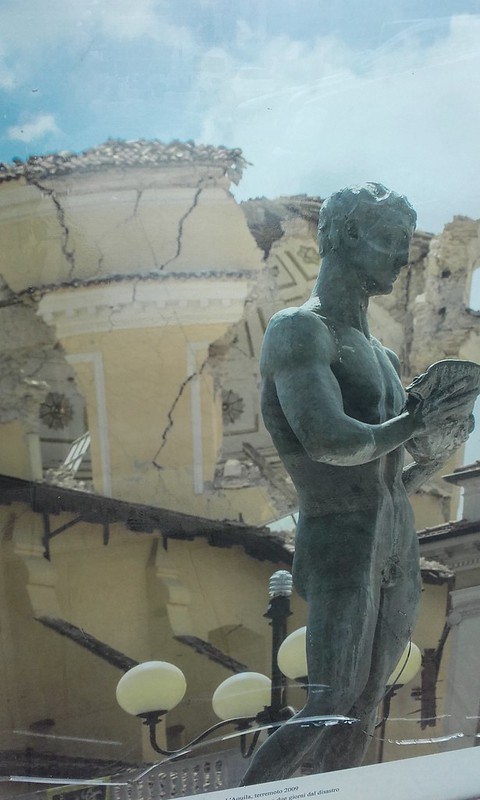L’Aquila
The next city along the route is L’Aquila, so we decide to stop there to buy things for lunch and get stamps for post cards. Just as we climb out of Emma, two men pass by and when we ask them where the post office is, they offer to take us there. They are both retired and out on their daily constitutional, so we stroll on down town with them, all the while getting the low-down on L’Aquila. We weren’t aware that this city was badly hit by an earthquake in 2009, killing over 300 people and ruining many houses. We pass a quarter where uninhabitable houses, waiting to be pulled down and rebuilt from scratch, mingle with brand new ones, built to top safety standards. At the time, 60 000 people lost their homes. To this day, 30 000 still live in temporary housing on the outskirts of L’Aquila, waiting to ‘return’ to a new house.
In the historic part of the city centre, it’s a different story. Here, each house is painstakingly being restored – the whole city centre is one great building site! A few houses are finished but most are surrounded by scaffolding, and those awaiting their turn have large wooden braces all around the outside and across the windows.
Business is closed for the most part, save a few cafes and a hotel, which seems to miraculously have survived the earthquake (maybe it was already built to safety specs).
The whole place looks like I imagine a city to look after a war. We speak to an architect involved in restoring historic facades. He reckons it will be at least another ten years before the town centre is back to business as before.
Here’s a photo that was taken just after the earth quake 8 years ago, and below is our photo of the same square now
Of course it’s a terrible disaster for a city to be struck by an earthquake like this. We’ve seen a number of places in Sicily, where in Baroque times, the whole population of a city moved, leaving the ruins behind and starting from scratch a few kilometers away, rather than going through the effort of rebuilding – resulting in a series of beautiful baroque cities in the Southern part of Sicily. I wonder who, in those times, carried the people’s loss, who paid for the work… because as we hear from the architect in Aquila, all the rebuilding is paid for by the state; the apartment blocks in the suburbs as well as the meticulous restoration of the historic buildings in the city centre. The cost must be astronomical!
However, not all is doom and gloom. The city hums with work – I don’t think anyone would be jobless here if they are willing to work in the construction industry. There is a spirit of optimism – we don’t see groups of men standing around smoking and looking depressed, like in so many other places in Italy. Despite all the scaffolding, it is clear that this city has an incredible wealth of historic buildings, and no doubt it will look absolutely spectacular once they are all restored.
Outside the ancient city walls, near the castle, which largely escaped damage, stands a square-ish, colourful building. It is a theatre called Teatro Stabilo, gifted to the city after the earthquake, presumably to keep up the spirit in a time of great hardship. As we drive out of the city, we pass graffiti slogans about not giving up, about loving this piece of earth – ‘my place is here, I will not leave’.
Humans have an incredible ability to rise out of the ashes, to start anew, to come out of such a disaster even stronger than before.
Here is the link to the photos of this chapter
Posted in Uncategorizedwith comments disabled.


